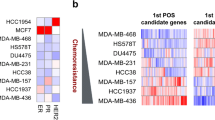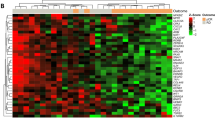Abstract
Background
We aimed to identify, through a review of the literature, candidate genes for a prospective predictive chemosensitivity test in patients with breast cancer.
Methods
Papers demonstrating an association between gene alterations in tumor tissue and clinical chemosensitivity in breast cancer patients were selected by Medline searches. We calculated odds ratios (ORs) and their 95% confidence intervals (CIs) of response rates for patients who had tumors with or without gene alteration. Combined ORs and CIs were estimated using the DerSimonian-Laird method.
Results
A total of 18 genes were evaluated for association with clinical chemosensitivity in 6378 patients registered in 69 studies. The median (range) number of patients in each study was 73 (29–319). Overexpression of ABCB1 (P-glycoprotein) was associated with poor responses to first-line chemotherapy (combined OR [CI], 0.16 [0.05–0.59]; n = 322). Overexpression and amplification of TOP2A (topoisomerase II-alfa) were more frequently observed in patients who responded to first-line chemotherapy (combined OR [CI], 2.73 [1.02–7.27]; n = 323). Overexpression of ERBB2 (c-erbB2) was associated with favorable responses in patients treated with both first-line anthracycline-based chemotherapy and second-line taxane-based chemotherapy (combined ORs [CIs], 1.60 [1.19–2.17]; n = 1807 and 2.24 [1.06–4.74]; n = 259, respectively). BCL2 overexpression was associated with resistance to first-line chemotherapy (combined OR [CI], 0.44 [0.21–0.91]; n = 816).
Conclusion
ABCB1, TOP2A, ERBB2, and BCL2 were good candidates for future clinical trials of predictive chemosensitivity tests in patients with breast cancer.
Similar content being viewed by others
References
Ellis MJHD, Lippman ME (2003) Treatment of metastatic breast cancer. In: Harris JRLM, Morrow M, Osborne CK (eds) Diseases of the breast, third edn. Lippincott Williams & Wilkins, Philadelphia, pp 1101–1159
Cortazar P, Johnson BE (1999) Review of the efficacy of individualized chemotherapy selected by in vitro drug sensitivity testing for patients with cancer. J Clin Oncol 17:1625–1631
Fruehauf JP, Alberts DS (2003) Assay-assisted treatment selection for women with breast or ovarian cancer. Recent Results Cancer Res 161:126–145
Sekine I, Minna JD, Nishio K, et al. (2007) Genes regulating the sensitivity of solid tumor cell lines to cytotoxic agents: a literature review. Jpn J Clin Oncol 37:329–336
Sekine I, Minna JD, Nishio K, et al. (2006) A literature review of molecular markers predictive of clinical response to cytotoxic chemotherapy in patients with lung cancer. J Thorac Oncol 1:31–37
Gottesman MM, Fojo T, Bates SE (2002) Multidrug resistance in cancer: role of ATP-dependent transporters. Nat Rev Cancer 2:48–58
Trock BJ, Leonessa F, Clarke R (1997) Multidrug resistance in breast cancer: a meta-analysis of MDR1/gp170 expression and its possible functional significance. J Natl Cancer Inst 89:917–931
Kellner U, Sehested M, Jensen PB, et al. (2002) Culprit and victim — DNA topoisomerase II. Lancet Oncol 3:235–243
Di Leo A, Isola J (2003) Topoisomerase II alpha as a marker predicting the efficacy of anthracyclines in breast cancer: are we at the end of the beginning? Clin Breast Cancer 4:179–186
Zhou BP, Hung MC (2003) Dysregulation of cellular signaling by HER2/neu in breast cancer. Semin Oncol 30:38–48
Ross JS, Fletcher JA, Bloom KJ, et al. (2003) HER-2/neu testing in breast cancer. Am J Clin Pathol 120(Suppl):S53–71
Yamauchi H, Stearns V, Hayes DF (2001) When is a tumor marker ready for prime time? A case study of c-erbB-2 as a predictive factor in breast cancer. J Clin Oncol 19:2334–2356
Mano MS, Rosa DD, De Azambuja E, et al. (2007) The 17q12–q21 amplicon: Her2 and topoisomerase-II alpha and their importance to the biology of solid tumours. Cancer Treat Rev 33:64–77
Arriola E, Marchio C, Tan DS, et al. (2008) Genomic analysis of the HER2/TOP2A amplicon in breast cancer and breast cancer cell lines. Lab Invest 88:491–503
Lacroix M, Toillon RA, Leclercq G (2006) p53 and breast cancer, an update. Endocr Relat Cancer 13:293–325
Cimoli G, Malacarne D, Ponassi R, et al. (2004) Meta-analysis of the role of p53 status in isogenic systems tested for sensitivity to cytotoxic antineoplastic drugs. Biochim Biophys Acta 1705:103–120
Davis JM, Navolanic PM, Weinstein-Oppenheimer CR, et al. (2003) Raf-1 and Bcl-2 induce distinct and common pathways that contribute to breast cancer drug resistance. Clin Cancer Res 9:1161–1170
Hamilton A, Piccart M (2000) The contribution of molecular markers to the prediction of response in the treatment of breast cancer: a review of the literature on HER-2, p53 and BCL-2. Ann Oncol 11:647–663
Ro J, Sahin A, Ro JY, et al. (1990) Immunohistochemical analysis of P-glycoprotein expression correlated with chemotherapy resistance in locally advanced breast cancer. Hum Pathol 21:787–791
Veneroni S, Zaffaroni N, Daidone MG, et al. (1994) Expression of P-glycoprotein and in vitro or in vivo resistance to doxorubicin and cisplatin in breast and ovarian cancers. Eur J Cancer 30A:1002–1007
Chevillard S, Pouillart P, Beldjord C, et al. (1996) Sequential assessment of multidrug resistance phenotype and measurement of S-phase fraction as predictive markers of breast cancer response to neoadjuvant chemotherapy. Cancer 77:292–300
Bottini A, Berruti A, Bersiga A, et al. (2000) p53 but not bcl-2 immunostaining is predictive of poor clinical complete response to primary chemotherapy in breast cancer patients. Clin Cancer Res 6:2751–2758
Burger H, Foekens JA, Look MP, et al. (2003) RNA expression of breast cancer resistance protein, lung resistance-related protein, multidrug resistance-associated proteins 1 and 2, and multidrug resistance gene 1 in breast cancer: correlation with chemotherapeutic response. Clin Cancer Res 9:827–836
Foekens JA, Romain S, Look MP, et al. (2001) Thymidine kinase and thymidylate synthase in advanced breast cancer: response to tamoxifen and chemotherapy. Cancer Res 61:1421–1425
Hasegawa S, Miyoshi Y, Egawa C, et al. (2003) Prediction of response to docetaxel by quantitative analysis of class I and III beta-tubulin isotype mRNA expression in human breast cancers. Clin Cancer Res 9:2992–2997
Jarvinen TA, Holli K, Kuukasjarvi T, et al. (1998) Predictive value of topoisomerase II alpha and other prognostic factors for epirubicin chemotherapy in advanced breast cancer. Br J Cancer 77:2267–2273
Coon JS, Marcus E, Gupta-Burt S, et al. (2002) Amplification and overexpression of topoisomerase II alpha predict response to anthracycline-based therapy in locally advanced breast cancer. Clin Cancer Res 8:1061–1067
MacGrogan G, Rudolph P, Mascarel Id I, et al. (2003) DNA topoisomerase II alpha expression and the response to primary chemotherapy in breast cancer. Br J Cancer 89:666–671
Martin-Richard M, Munoz M, Albanell J, et al. (2004) Serial topoisomerase II expression in primary breast cancer and response to neoadjuvant anthracycline-based chemotherapy. Oncology 66:388–394
Park K, Kim J, Lim S, et al. (2003) Topoisomerase II-alpha (topoII) and HER2 amplification in breast cancers and response to preoperative doxorubicin chemotherapy. Eur J Cancer 39:631–634
Wright C, Cairns J, Cantwell BJ, et al. (1992) Response to mitoxantrone in advanced breast cancer: correlation with expression of c-erbB-2 protein and glutathione S-transferases. Br J Cancer 65:271–274
Egawa C, Motomura K, Miyoshi Y, et al. (2003) Increased expression of BRCA1 mRNA predicts favorable response to anthracycline-containing chemotherapy in breast cancers. Breast Cancer Res Treat 78:45–50
Bonnefoi H, Diebold-Berger S, Therasse P, et al. (2003) Locally advanced/inflammatory breast cancers treated with intensive epirubicin-based neoadjuvant chemotherapy: are there molecular markers in the primary tumour that predict for 5-year clinical outcome? Ann Oncol 14:406–413
Niskanen E, Blomqvist C, Franssila K, et al. (1997) Predictive value of c-erbB-2, p53, cathepsin-D and histology of the primary tumour in metastatic breast cancer. Br J Cancer 76:917–922
Rozan S, Vincent-Salomon A, Zafrani B, et al. (1998) No significant predictive value of c-erbB-2 or p53 expression regarding sensitivity to primary chemotherapy or radiotherapy in breast cancer. Int J Cancer 79:27–33
Vincent-Salomon A, Carton M, Freneaux P, et al. (2000) ERBB2 overexpression in breast carcinomas: no positive correlation with complete pathological response to preoperative high-dose anthracycline-based chemotherapy. Eur J Cancer 36:586–591
Geisler S, Lonning PE, Aas T, et al. (2001) Influence of TP53 gene alterations and c-erbB-2 expression on the response to treatment with doxorubicin in locally advanced breast cancer. Cancer Res 61:2505–2512
Zhang F, Yang Y, Smith T, et al. (2003) Correlation between HER-2 expression and response to neoadjuvant chemotherapy with 5-fluorouracil, doxorubicin, and cyclophosphamide in patients with breast carcinoma. Cancer 97:1758–1765
Burcombe RJ, Makris A, Richman PI, et al. (2005) Evaluation of ER, PgR, HER-2 and Ki-67 as predictors of response to neoadjuvant anthracycline chemotherapy for operable breast cancer. Br J Cancer 92:147–155
Prisack HB, Karreman C, Modlich O, et al. (2005) Predictive biological markers for response of invasive breast cancer to anthracycline/ cyclophosphamide-based primary (radio-) chemotherapy. Anticancer Res 25:4615–4621
Manna Edel F, Teixeira LC, Alvarenga M (2006) Association between immunohistochemical expression of topoisomerase II alpha, HER2 and hormone receptors and response to primary chemotherapy in breast cancer. Tumori 92:222–229
Konecny GE, Thomssen C, Luck HJ, et al. (2004) Her-2/neu gene amplification and response to paclitaxel in patients with metastatic breast cancer. J Natl Cancer Inst 96:1141–1151
Bozzetti C, Musolino A, Camisa R, et al. (2006) Evaluation of HER-2/neu amplification and other biological markers as predictors of response to neoadjuvant anthracycline-based chemotherapy in primary breast cancer: the role of anthracycline dose intensity. Am J Clin Oncol 29:171–177
Baselga J, Seidman AD, Rosen PP, et al. (1997) HER2 overexpression and paclitaxel sensitivity in breast cancer: therapeutic implications. Oncology (Williston Park) 11:43–48
Sjostrom J, Collan J, von Boguslawski K, et al. (2002) C-erbB-2 expression does not predict response to docetaxel or sequential methotrexate and 5-fluorouracil in advanced breast cancer. Eur J Cancer 38:535–542
Di Leo A, Chan S, Paesmans M, et al. (2004) HER-2/neu as a predictive marker in a population of advanced breast cancer patients randomly treated either with single-agent doxorubicin or single-agent docetaxel. Breast Cancer Res Treat 86:197–206
Frassoldati A, Adami F, Banzi C, et al. (1997) Changes of biological features in breast cancer cells determined by primary chemotherapy. Breast Cancer Res Treat 44:185–192
Bonetti A, Zaninelli M, Leone R, et al. (1998) bcl-2 but not p53 expression is associated with resistance to chemotherapy in advanced breast cancer. Clin Cancer Res 4:2331–2336
Colleoni M, Orvieto E, Nole F, et al. (1999) Prediction of response to primary chemotherapy for operable breast cancer. Eur J Cancer 35:574–579
Kandioler-Eckersberger D, Ludwig C, Rudas M, et al. (2000) TP53 mutation and p53 overexpression for prediction of response to neoadjuvant treatment in breast cancer patients. Clin Cancer Res 6:50–56
Rahko E, Blanco G, Soini Y, et al. (2003) A mutant TP53 gene status is associated with a poor prognosis and anthracycline-resistance in breast cancer patients. Eur J Cancer 39:447–453
Ogston KN, Miller ID, Schofield AC, et al. (2004) Can patients’ likelihood of benefiting from primary chemotherapy for breast cancer be predicted before commencement of treatment? Breast Cancer Res Treat 86:181–189
Berns EM, Foekens JA, Vossen R, et al. (2000) Complete sequencing of TP53 predicts poor response to systemic therapy of advanced breast cancer. Cancer Res 60:2155–2162
Geisler S, Borresen-Dale AL, Johnsen H, et al. (2003) TP53 gene mutations predict the response to neoadjuvant treatment with 5-fluorouracil and mitomycin in locally advanced breast cancer. Clin Cancer Res 9:5582–5588
Buchholz TA, Garg AK, Chakravarti N, et al. (2005) The nuclear transcription factor kappaB/bcl-2 pathway correlates with pathologic complete response to doxorubicin-based neoadjuvant chemotherapy in human breast cancer. Clin Cancer Res 11: 8398–8402
Sjostrom J, Blomqvist C, von Boguslawski K, et al. (2002) The predictive value of bcl-2, bax, bcl-xL, bag-1, fas, and fasL for chemotherapy response in advanced breast cancer. Clin Cancer Res 8:811–816
Krajewski S, Blomqvist C, Franssila K, et al. (1995) Reduced expression of proapoptotic gene BAX is associated with poor response rates to combination chemotherapy and shorter survival in women with metastatic breast adenocarcinoma. Cancer Res 55:4471–4478
Author information
Authors and Affiliations
Corresponding author
About this article
Cite this article
Sekine, I., Shimizu, C., Nishio, K. et al. A literature review of molecular markers predictive of clinical response to cytotoxic chemotherapy in patients with breast cancer. Int J Clin Oncol 14, 112–119 (2009). https://doi.org/10.1007/s10147-008-0813-z
Received:
Accepted:
Published:
Issue Date:
DOI: https://doi.org/10.1007/s10147-008-0813-z




